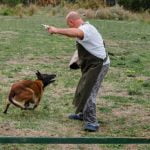Are you wondering how to train a dog for protection? Training your canine companion to protect you and your family is not just about teaching them to bark and bite on command. It’s about building trust, establishing clear communication, and instilling obedience. In this article, we will explore the various aspects of protection training, from choosing the right breed to advanced techniques like aggression control.
Choosing the right dog breed is crucial when it comes to protection training. Some breeds are naturally more inclined towards protective behavior, while others may require more intensive training. Building a strong foundation of trust and communication with your dog is also essential before delving into protection training. This includes basic obedience training and ensuring that your dog understands and responds to your commands effectively.
Once the fundamentals are in place, you can introduce scent work, tracking, and teaching your dog to bark on command and respond to threats. Advanced techniques such as bite work and aggression control can then be implemented under the guidance of a professional trainer. Consistency and continued training play a vital role in maintaining your dog’s protection skills over time, creating a safe environment for both your family and your trained protection dog.
As we delve into each aspect of protection training, keep in mind that the ultimate goal is not just to have a guard dog but also a well-behaved companion who can provide security when needed. With dedication and proper training, you can enjoy the benefits of having a confident and protective canine partner by your side.
Choosing the Right Dog Breed for Protection Training
When it comes to choosing the right dog breed for protection training, it’s important to consider the natural instincts and characteristics of the breed. Different breeds have different strengths and abilities, so selecting the right one is crucial for successful protection training. Here are some factors to consider when choosing a dog breed for protection training:
- Temperament: Look for breeds known for their loyalty, bravery, and protective nature. It’s essential to choose a breed that is naturally inclined to protect its family and territory.
- Size and strength: Larger, more muscular breeds are often preferred for protection work due to their physical presence and ability to deter potential threats.
- Trainability: Choose a breed that is intelligent, eager to please, and easy to train. This will make the process of protection training much smoother and more effective.
Some popular dog breeds that are commonly used for protection training include German Shepherds, Belgian Malinois, Rottweilers, Doberman Pinschers, and Giant Schnauzers. These breeds possess the qualities needed for protection work and have a long history of being used in law enforcement and military roles.
Keep in mind that regardless of the breed you choose, proper socialization from an early age is crucial. This will help ensure that your dog is well-adjusted, confident, and able to differentiate between friend and foe. Additionally, ongoing training and reinforcement of protective behaviors are necessary for any breed selected for protection work.
Building Trust and Communication With Your Dog
Building a strong foundation of trust and communication with your dog is crucial when training them for protection. A well-trained protection dog must have a deep bond with their handler in order to effectively carry out their duties. Here are some vital steps to take in building trust and communication with your dog:
1. Spend quality time together: Dedicate regular one-on-one time with your dog to build a strong bond. Whether it’s through play, exercise, or simply spending time together, this will help strengthen your connection.
2. Consistent training: Consistency is key when training any dog, especially one being trained for protection. Ensure that you are consistent in your commands, rewards, and corrections to enhance communication between you and your dog.
3. Positive reinforcement: Use positive reinforcement techniques such as treats, praise, and affection to build trust with your dog during training sessions. This will create a positive association with their training and strengthen the bond between you.
By focusing on building trust and communication with your dog from the start, you are laying the groundwork for successful protection training. Remember that every interaction with your dog is an opportunity to reinforce this important bond, so make the most of each moment you spend together.
Basic Obedience Training
Before delving into advanced protection training techniques, it is crucial to establish a strong foundation of basic obedience training for your dog. Basic obedience commands such as sit, stay, come, and heel are essential for effective communication and control, which are vital in protection training.
One important aspect of basic obedience training is positive reinforcement. Using treats, praise, and rewards to encourage good behavior can help create a positive association with the training process for your dog. Consistency is also key – daily practice and reinforcement of commands will help solidify your dog’s understanding and compliance.
In addition to the standard obedience commands, leash manners are crucial for a protection dog. Proper leash etiquette enables you to maintain control of your dog in various situations, whether you are out for a walk or encountering potential threats. By mastering these foundational skills, you will set the stage for a successful transition into more advanced protection training techniques.
| Basic Obedience Training | Foundation of Protection Training |
|---|---|
| Positive reinforcement | Encourages good behavior |
| Consistency | Daily practice and reinforcement |
| Leash manners | Enables control in different situations |
Introduction to Scent Work and Tracking
Scent work and tracking are essential components of protection training for dogs. This aspect of training taps into a dog’s natural instincts and abilities, making it an effective tool for enhancing their protective skills. By introducing scent work and tracking, you can further develop your dog’s capabilities in detecting threats and locating individuals or items, making them a valuable asset in protecting you and your property.
The Power of a Dog’s Sense of Smell
A dog’s sense of smell is incredibly powerful, with some breeds having up to 300 million olfactory receptors in their noses. This exceptional ability allows them to detect scents that humans cannot even perceive. In protection training, harnessing this sense of smell through scent work enables dogs to track down intruders or locate missing persons in various environments. By understanding and leveraging their keen sense of smell, you can enhance your dog’s capabilities in protection tasks.
Training Methods for Scent Work and Tracking
Introducing scent work and tracking to your dog involves structured training methods that focus on developing their skills in detecting specific scents, following tracks, and locating hidden objects. This may include using scented articles for search exercises, laying scent trails for tracking practice, and teaching the dog to indicate the presence of a particular scent. Implementing positive reinforcement techniques coupled with patience and consistency is key to effectively train your dog in scent work and tracking.
By incorporating scent work and tracking into your dog’s protection training regimen, you can further enhance their abilities to detect potential threats and assist in safeguarding your home or property. These skills not only contribute to the overall effectiveness of a trained protection dog but also provide mental stimulation and fulfillment for the canine partner.
Teaching Barking on Command and Response to Threats
Training your dog to bark on command and respond to potential threats is an important aspect of protection training. This skill not only serves as a deterrent to would-be intruders, but it also allows your dog to alert you of any potential danger. To start this training, you will need a reliable command for your dog to bark, such as “speak” or “alert”. Use treats and positive reinforcement to associate the command with the action of barking.
Additionally, it’s essential to train your dog to differentiate between real threats and everyday occurrences. You can do this by introducing controlled scenarios and teaching your dog the appropriate response for each situation. For example, when someone approaches your property in a non-threatening manner, your dog should learn not to bark excessively or show aggression. On the other hand, when faced with a genuine threat, your dog should be able to respond appropriately.
Consistent training and socialization are crucial for teaching barking on command and response to threats. It’s important to practice these skills in various environments and with different stimuli so that your dog can generalize their training. Remember that while protection training is beneficial, it should never compromise the safety or well-being of others.
| Protection Training Skill | Description |
|---|---|
| Barking on Command | This skill involves teaching your dog to bark on cue, serving as a deterrent and alerting you of potential threats. |
| Response to Threats | Your dog learns how to differentiate between genuine threats and everyday occurrences, responding appropriately in each situation. |
Advanced Protection Training Techniques
Understanding Bite Work
Bite work is an advanced training technique that involves teaching your dog to use its mouth and teeth to defend or protect on command. This technique should only be attempted by experienced trainers, as it requires a deep understanding of a dog’s behavior and body language. Before starting bite work training, it is crucial to ensure that your dog has mastered basic obedience commands and has a solid foundation in protection training.
Teaching Aggression Control
While it may seem contradictory, aggression control is a key component of protection training for dogs. It involves teaching your dog when to display aggressive behavior and when to remain calm and composed. This aspect of training is essential for ensuring that your dog can differentiate between real threats and everyday situations.
Aggression control also includes teaching your dog how to de-escalate a potentially dangerous situation without resorting to biting or attacking. This can be achieved through structured exercises that simulate threatening scenarios, allowing the dog to practice controlled responses under the guidance of a professional trainer.
Seek Professional Guidance
As with any advanced training techniques, it is highly recommended to seek the guidance of a professional trainer who specializes in protection training for dogs. Attempting bite work and aggression control without proper knowledge and experience can result in serious injury or behavioral issues with your pet.
A qualified trainer will be able to assess your dog’s temperament, provide personalized instruction, and ensure that the training progresses at a pace that is suitable for both you and your canine companion.
By incorporating bite work and aggression control into your dog’s protection training regimen, you can further enhance their ability to protect you and your family in potential threat situations while maintaining safe and controlled behavior in everyday settings.
Creating a Safe Environment for Your Trained Protection Dog
When training a dog for protection, creating a safe environment is crucial for the well-being of both the dog and those around them. A trained protection dog needs a secure and consistent environment where they feel comfortable and can practice their skills without any unnecessary risks. This includes providing a designated area for training exercises and ensuring that the dog can relax and unwind when not working.
One important aspect of creating a safe environment for a trained protection dog is ensuring that they are properly contained and controlled at all times. Whether at home or in public places, it is essential to use leashes, harnesses, or other appropriate restraints to prevent the dog from wandering off or getting into situations where their protective instincts could lead to aggression. Proper containment also helps protect the dog from potential harm or injury.
Additionally, it’s important to educate others about your trained protection dog and set boundaries to avoid any misunderstandings or conflicts. Informing visitors, neighbors, and even strangers about your dog’s training and abilities can help prevent unnecessary fear or apprehension. By creating clear guidelines for interactions with the dog, you can ensure that everyone feels safe and comfortable in the presence of your trained protection dog.
The Importance of Consistency and Continued Training
Consistency and continued training are crucial aspects of successfully training a dog for protection. Once your dog has learned the basic obedience and protection training techniques, it is important to maintain a consistent training schedule to reinforce these behaviors. Consistency helps your dog understand what is expected of them and reinforces their training, leading to better retention of commands and behaviors.
Continued training also ensures that your dog stays sharp and maintains their skills over time. Just like any other skill, if not practiced regularly, the training can diminish. Regular practice of protection training techniques will keep your dog prepared to respond effectively to potential threats or dangerous situations.
In addition to regular training sessions, it is important to continuously challenge your dog with new scenarios and environments. This will help them generalize their protective behaviors so they can respond appropriately in a variety of situations. It also keeps the training interesting for your dog, preventing boredom and maintaining their focus on their protective duties. By consistently challenging and refreshing your dog’s skills, you can ensure they remain a reliable protection companion.
Conclusion
Training your dog for protection can be a rewarding and beneficial experience for both you and your furry companion. Not only does it provide a sense of security for you and your family, but it also strengthens the bond between you and your dog. By investing time and effort into protection training, you are giving your dog a purpose and a job to do, which fulfills their natural instincts and can lead to a happier, more balanced pet.
Additionally, having a well-trained protection dog can provide peace of mind in various situations, such as home invasions or when out on walks. The obedience and control instilled through protection training can prevent potentially dangerous situations from escalating, ultimately keeping you and your dog safe.
Overall, the benefits of training your dog for protection extend far beyond just safeguarding your home. It builds confidence in your canine companion, deepens the trust between the two of you, and ensures that they are equipped with the skills necessary to respond effectively in times of need. While it may require dedication, consistency, and patience, the rewards of having a trained protection dog make the process well worth it.
Frequently Asked Questions
Can I Train My Dog to Be a Protection Dog?
Yes, it is possible to train your dog to be a protection dog with the right training and temperament. This type of training usually involves teaching the dog to protect its owner from perceived threats through advanced obedience training, bite work, and controlled aggression.
It’s important to work with a professional trainer who specializes in protection dog training to ensure safety and effectiveness.
What Is a Level 1 Protection Dog?
A Level 1 protection dog is typically trained for basic protection skills such as barking at strangers, alerting its owner to potential threats, and creating a visual deterrent. These dogs are trained to show controlled aggression when their owner is threatened, but they are not typically trained for advanced attack techniques.
Level 1 protection dogs are a good option for individuals looking for added security without aggressive behavior.
How Do You Test if Your Dog Will Protect You?
Testing if your dog will protect you can involve observing its natural instincts towards protecting you or your property, monitoring its response to potential threats during walks or at home, and seeking the guidance of a professional trainer experienced in protection dog behavior.
It’s important to remember that not all dogs have the temperament or training for protection work, so assessing this aspect carefully is crucial for both the safety of the owner and the well-being of the dog.

Welcome to the blog! I am a professional dog trainer and have been working with dogs for many years. In this blog, I will be discussing various topics related to dog training, including tips, tricks, and advice. I hope you find this information helpful and informative. Thanks for reading!





